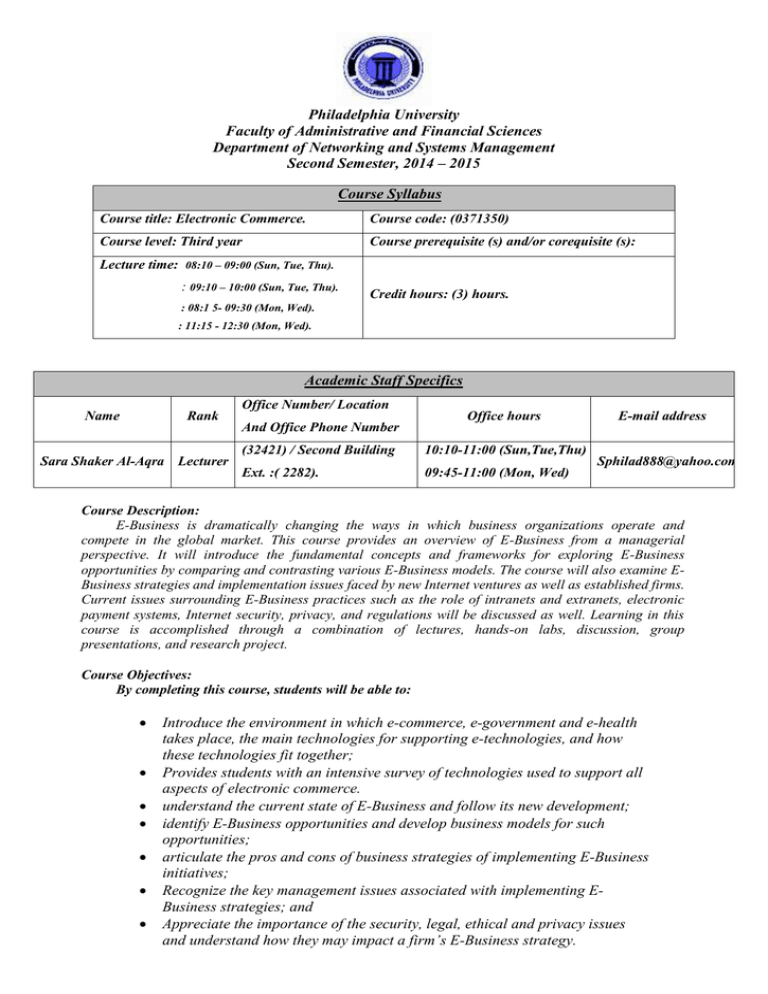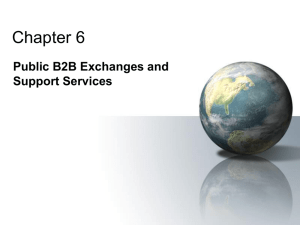Philadelphia University Faculty of Administrative and Financial Sciences
advertisement

Philadelphia University Faculty of Administrative and Financial Sciences Department of Networking and Systems Management Second Semester, 2014 – 2015 Course Syllabus Course title: Electronic Commerce. Course code: (0371350) Course level: Third year Course prerequisite (s) and/or corequisite (s): Lecture time: 08:10 – 09:00 (Sun, Tue, Thu). : 09:10 – 10:00 (Sun, Tue, Thu). Credit hours: (3) hours. : 08:1 5- 09:30 (Mon, Wed). : 11:15 - 12:30 (Mon, Wed). Academic Staff Specifics Name Rank Sara Shaker Al-Aqra Lecturer Office Number/ Location And Office Phone Number Office hours (32421) / Second Building 10:10-11:00 (Sun,Tue,Thu) Ext. :( 2282). 09:45-11:00 (Mon, Wed) E-mail address Sphilad888@yahoo.com Course Description: E-Business is dramatically changing the ways in which business organizations operate and compete in the global market. This course provides an overview of E-Business from a managerial perspective. It will introduce the fundamental concepts and frameworks for exploring E-Business opportunities by comparing and contrasting various E-Business models. The course will also examine EBusiness strategies and implementation issues faced by new Internet ventures as well as established firms. Current issues surrounding E-Business practices such as the role of intranets and extranets, electronic payment systems, Internet security, privacy, and regulations will be discussed as well. Learning in this course is accomplished through a combination of lectures, hands-on labs, discussion, group presentations, and research project. Course Objectives: By completing this course, students will be able to: Introduce the environment in which e-commerce, e-government and e-health takes place, the main technologies for supporting e-technologies, and how these technologies fit together; Provides students with an intensive survey of technologies used to support all aspects of electronic commerce. understand the current state of E-Business and follow its new development; identify E-Business opportunities and develop business models for such opportunities; articulate the pros and cons of business strategies of implementing E-Business initiatives; Recognize the key management issues associated with implementing EBusiness strategies; and Appreciate the importance of the security, legal, ethical and privacy issues and understand how they may impact a firm’s E-Business strategy. Course Components: Support material (s). Study guide (s). Homework and laboratory guide (s) if (applicable). Books (title , author (s), publisher, year of publication) Electronic Commerce, A Managerial Perspective 2006 Authors: Efraim Turban, David King, Dennis Viehland, and, Jae Lee Publisher: Prentice Hall, 2006 ISBN: 0-13-185461-5 Optional Text box: E-Commerce: Business, Technology, Society – 2nd edition Authors: Kenneth C. Laudon & Carol Traver Publisher: Addison Wesley, 2004 ISBN: 0-321-20056-X Teaching Methods: Lectures. Discussion groups. Tutorials. Debates. Homework’s. Small Project. Research Paper Hands-in labs. Lab Assignment in Labs. Learning Outcomes: Knowledge and understanding: Upon completing this module, a student will: understand the main technologies behind electronic systems and how these technologies interact; Have understandings of how e-commerce and web based applications are designed, built and implemented. Have knowledge of tools, technologies, concepts and processes that comprise the technical infrastructure of e-commerce sites and be able to solve problems about site design, hardware and software architecture, and document architecture. Cognitive Skills (thinking and analysis): A number of queries are given to the student in the lecture to encourage him make a brain storm. This will definitely help him understand more how to work it out. This is done by offering the idea to students then encourages them to discuss it theoretically. This of course will help them practice in an effective way. Communication Skills (personal and academic): - A round is done in the class by the instructor to monitor how the practical part of the course is done to make sure that it is done effectively. Problems that may appear from time to time in the lecture are solved. - Every lecture there will be five minutes open for discussion. For best discussion, the students are welcome at the lecturer office hours. - Group Management: Students work on group projects (approximately two to three students) to practice interpersonal skills by communicating with group members, other groups, and peers outside the group. Practical and Subject Specific Skills (Transferable Skills): A project is given to the student to use his mental capabilities to solve the problem. This way of demonstrating the course was fruitful taking into account the recognized results achieved. It was not quiet convenient because the short time the students spend in solving the problem. Assessment Instruments Short Reports and/ or Presentations and/ or Short Research Projects. Quizzes. Homework. Final Examination. Attendance. Allocation of Marks Assessment Instruments Mark First Examination 20 Second Examination 20 Final Examination 40 - Project or Research: (5 marks). 20 Exam Date and Day - Quizzes or reports or home works: (5 marks). - Student Projects / researches discussion or presentation: (5 marks). - Student attendance (presence and absence): (5 marks). Total 100 Documentation and Academic Honesty Documentation style (with illustrative examples). Protection by copyright Avoiding plagiarism. Definition of Plagiarism Plagiarism is the unacknowledged borrowing of another writer’s words or ideas. How Can Students Avoid Plagiarism? To avoid plagiarism, you must give credit whenever you use another person’s idea, opinion, or theory; any facts, statistics, graphs, drawings—any pieces of information—that are not common knowledge; quotations of another person’s actual spoken or written words; or Paraphrase of another person’s spoken or written words. If you are in doubt about whether what you are doing is inappropriate, consult your instructor. A claim that “you didn’t know it was wrong” will not be accepted as an excuse. Penalty for Plagiarism The minimum penalty for an act of plagiarism is a 0 on the assignment, homework, and project. Serious cases of plagiarism may result in failure in the course as a whole, or expulsion from the university. Course/Module Academic Calendar Week (1) (2) (3) (4) (5) (6) Basic and support material to be covered Ch(1): Overview of Electronic Commerce: - Electronic Commerce definitions and concepts (E Commerce, E Business, Pure EC, Partial EC...). - The EC Framework, Classification, and Contents. - The Digital Revolution Drives EC. - The Business Environment drives EC. - EC Business Models. - Benefits and Limitations of EC. - Networks for EC. Ch(2):E-Marketplaces: - Market space components. - Types of Marketplaces (Storefronts, Malls, and Information portals, E-marketplaces). - Intermediation in EC. - Electronic catalogs and other market mechanisms (Search engines, intelligent agents, and shopping carts). - Auctions as EC Market mechanisms (definition &characteristics, traditional versus E-Auctions, dynamic pricing, and types of auctions). - Bartering and Negotiating Online. - EC in the wireless environment. - Competition in the digital economy. Impacts of EC on business processes and organizations. Ch(3):Retailing in Electronic Commerce: - Internet Marketing and Electronic Retailing (overview of Electronic retailing, size and growth of the B2C market, what sells well on the internet, and characteristics of successful E-tailing). - E-Tailing Business Models. - Travel and Tourism Services Online (Services, benefits and limitations, corporate travel, and intelligent agents in travel services). - Employment Placement and the Job Market Online (the internet job market, benefits and limitations, and intelligent agents in the electronic job market). - Real estate, Insurance, and Stock trading online. - Banking and personal finance online. - On-Demand Delivery Services and E-grocers. - Online Delivery of Digital Products, Entertainment, and Media. - Online Purchase-Decision Aids. - Successful Click-and-Mortar Strategies. - Problems with E-tailing and Lessons Learned. - First exam review. - First Exam. Homework/reports and their due dates - First Examination First Examination (7) (8) (9) (10) (11) Second Ch(4): Consumer Behavior, Market Research, and Advertisement: -Learning about Consumer Behavior Online. -The Consumer Decision-Making Process. -One-to-One Marketing, Loyalty, and Trust in EC. - Market Research for EC (Market segmentation, Online market research methods, Limitations of online market research). - Internet Marketing in B2B. - Web Advertising (Overview, Some Internet Advertising Terminology, Why Internet Advertising, Advertising networks). - Advertising Methods (Banners, Pop up ad, E mail Advertising …). - Advertising Strategies and Promotions Online. - Special Advertising Topics (Permission advertising, Ad management, Localization). - Software Agents in Marketing and Advertising Applications. - First Examination Ch(5):B2B E-Commerce: Selling and Buying in Private E-Markets: - Concepts, Characteristics, and Models of B2B EC (Basic concepts, Types of B2E EC, Basic types of B2B E marketplaces, Online Intermediary, Types of transactions, Supply chain relationships in B2B, Virtual services, B2B benefits and limitations). - One-to-Many: Sell-Side E-Marketplaces (Models and Activities, Direct Sales from Catalogs). - Selling via Intermediaries (Using auctions on the sell side, Selling from the Company’s Own Site). -One-from-Many: Buy-Side E-Marketplaces and EProcurement (Buy-side e-marketplace, Procurement Methods, Benefits and goals of E-Procurement, Implementing E-Procurement). - Buy-Side E-Marketplaces: Reverse Auctions. - Other E-Procurement Methods (E auctions, Group purchasing, Electronic bartering …). - Automating B2B Tasks (Contract management, Spend management, Sourcing Management and Negotiation, E-Procurement Management). - Infrastructure, Integration, and Software Agents in B2B EC. Ch(6): Public B2B Exchanges and Support Services: - B2B Electronic Exchanges - An Overview (Classification of exchanges, Dynamic pricing, Functions of exchanges, Ownerships, Governance and Organization of exchanges). - B2B Portals and vortals. - Third-Party (Trading) Exchanges (Properties, Market liquidity, Aggregation models). - Consortium Trading Exchanges (Definition, Purchasing - Oriented Consortia, selling oriented consortia, and other issues). - Second exam review. - Second exam. - Second Examination - Building and Integrating E-Marketplaces and Exchanges (Building E-Marketplaces, and the Integration Issue). - Support Services for E-Marketplaces and PRM (Directory services and search engines, Partner and Examination (12) (13) (14) (15) Specimen Examination (Optional) (16) Final Examination supplier relationship management, and E-Communities and PRM). - B2B Networks (Company-Centered (Private) Networks, Industry-wide (Vertical) Networks, and Trans-industry and Global Networks). - B2B Implementation Issues ( Private marketplaces - Second Examination and its problems, Public exchange and its problems, Software Agents in B2B Exchanges, and Disintermediation and Reintermediation ). - Managing Exchanges (Centralized Management, Critical Success Factors for Exchanges, and new Directions for B2B Marketplaces). - Ch(9): Mobile Commerce and Pervasive Computing: - Mobile Computing (Overview of Mobile Commerce, Mobile Computing (Devices, Infrastructure, Software, and services). -Wireless Telecommunications Networks (PAN, WLAN, WMAN, WWAN, SIM, Cellular Telephone Network, WWAN Communication Bandwidths, WWAN Communication Protocols). - Mobile Commerce (Attributes And Drivers). - Mobile Financial Applications (Mobile Banking and Wireless Electronic Payment Systems, Wireless Bill Payments). - Mobile Shopping, Advertising, and Content Provision (Wireless Shopping, Targeted Advertising, and mobile portal). - Mobile Intrabusiness Applications (Support of Mobile Employees, Customer Support, Non-Internet Intrabusiness Applications). - B2B M-Commerce and Supply Chain Management. -Mobile Consumer and Personal Service Applications (Mobile games, Wireless Telemedicine …). - Location-Based Mobile Commerce (Concepts, Emergency Response Cell Phone Calls, Telematics, Barriers to Location-Based M-Commerce). -Security and Other Barriers to Mobile Commerce (MCommerce Security Issues, Technological Barriers to M-Commerce, Ethical, Legal, and Health Issues in M-Commerce, and Project Failures in M-Commerce). - Pervasive Computing (Overview, Initiatives, and Barriers). - Final Examination - Presentation of students' researches. - Comprehensive review for all the topics learned in the whole semester. - Final exam. Expected Workload: On average students need to spend 2 hours of study and preparation for each 50-minute lecture/tutorial. Attendance Policy: Absence from lectures and/or tutorials shall not exceed 15%. Students who exceed the 15% limit without a medical or emergency excuse acceptable to and approved by the Dean of the relevant college/faculty shall not be allowed to take the final examination and shall receive a mark of zero for the course. If the excuse is approved by the Dean, the student shall be considered to have withdrawn from the course.


